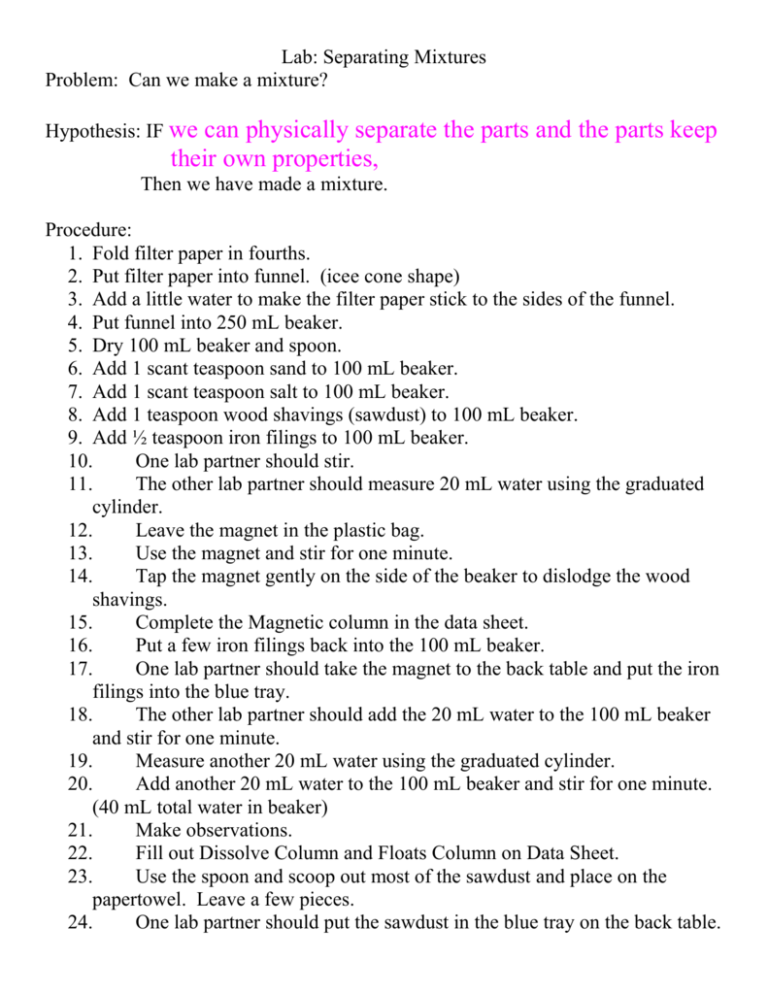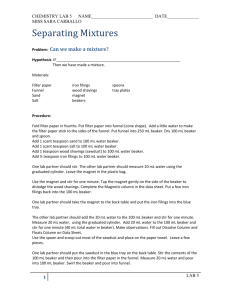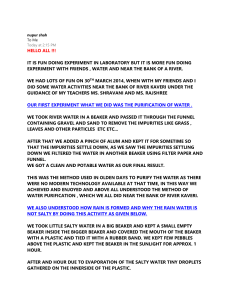Lab: Separating Mixtures
advertisement

Lab: Separating Mixtures Problem: Can we make a mixture? Hypothesis: IF we can physically separate the parts and the parts keep their own properties, Then we have made a mixture. Procedure: 1. Fold filter paper in fourths. 2. Put filter paper into funnel. (icee cone shape) 3. Add a little water to make the filter paper stick to the sides of the funnel. 4. Put funnel into 250 mL beaker. 5. Dry 100 mL beaker and spoon. 6. Add 1 scant teaspoon sand to 100 mL beaker. 7. Add 1 scant teaspoon salt to 100 mL beaker. 8. Add 1 teaspoon wood shavings (sawdust) to 100 mL beaker. 9. Add ½ teaspoon iron filings to 100 mL beaker. 10. One lab partner should stir. 11. The other lab partner should measure 20 mL water using the graduated cylinder. 12. Leave the magnet in the plastic bag. 13. Use the magnet and stir for one minute. 14. Tap the magnet gently on the side of the beaker to dislodge the wood shavings. 15. Complete the Magnetic column in the data sheet. 16. Put a few iron filings back into the 100 mL beaker. 17. One lab partner should take the magnet to the back table and put the iron filings into the blue tray. 18. The other lab partner should add the 20 mL water to the 100 mL beaker and stir for one minute. 19. Measure another 20 mL water using the graduated cylinder. 20. Add another 20 mL water to the 100 mL beaker and stir for one minute. (40 mL total water in beaker) 21. Make observations. 22. Fill out Dissolve Column and Floats Column on Data Sheet. 23. Use the spoon and scoop out most of the sawdust and place on the papertowel. Leave a few pieces. 24. One lab partner should put the sawdust in the blue tray on the back table. 25. Stir the contents of the 100 mL beaker and then pour into the filter paper in the funnel. 26. Measure another 20 mL water and pour into 100 mL beaker. 27. Swirl the beaker and pour into funnel. 28. One lab partner should rinse out the 100 mL beaker in the sink. 29. Make observations of the filtration system. 30. Complete the Filtered column on the data table. 31. Put the filter paper and contents in the blue tray on the back table. 32. Clean up everything at your lab table. Substance Salt Iron Sand Sawdust Dissolves in water Floats in Water Magnetic Filtered Y N N N N N Y Y N N N Y N Y N Y Analysis and Conclusion Questions 1. Describe how each substance was able to keep its own physical properties when it was mixed with another substance. Salt – dissolved in water; not magnetic; did not float; was not filtered Iron filings – magnetic; filtered; didn’t dissolve in water; didn’t float Sand – filtered by filter paper; didn’t dissolve in water; not magnetic; didn’t float Saw dust – floated; filtered; didn’t dissolve; not magnetic 2. How do you know that each combination was NOT a chemical combination? -The substances kept their own properties after they were mixed. -The substances were separated by physical means: magnetism to separate iron; scooped out floating sawdust; filtered out sand; allow water to evaporate and salt would be left behind. -A chemical reaction did not occur. 3. If small pieces of plastic yogurt cup, aquarium gravel, sugar, and finishing nails were mixed together in one container, how would you separate the mixture? List the steps in the order you would do them. Step 1. 2. Substance Separated from Mixture Finishing nails How would you separate it? Use a magnet to pull them out of the mixture. 3. 4.





